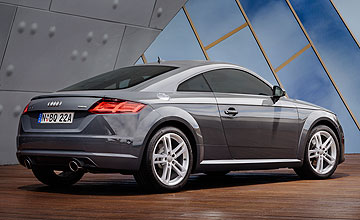BY TUNG NGUYEN | 19th Feb 2015

A styling sensation when it debuted as a show-stopping concept car 20 years ago, the Bauhaus-inspired original did two things to the hitherto struggling German premium brand when released in production form four years later: One, it legitimised great design for design’s sake and, two, it set Audi on a quest to push quality boundaries with each successive model.
That the TT didn’t really steer or handle like the taut sports car that the wonderful styling promised didn’t really matter when so many other things about the Ingolstadt superstar shone so brightly.
Still, widespread dynamic criticism meant that the 2006 replacement ditched the Mk4 Golf/Mk1 A3 chassis for aluminium space-frame tech, bringing an aluminium front half and high-strength steel in the rear, topped by a multi-link rear suspension system and much quicker steering. Result? The now-80kg lighter TT turned athletic.
But in other areas, the Mk2 wasn’t so special. The new design lost its purity, especially around the pinched face. The cabin seemed somewhat underwhelming, and the ride could be punishing.
Eight years on, though, and the Germans appear to have finally dotted all the Is and crossed all the, ahem, TTs.
Take the styling. Using the R8’s handsome face as inspiration for the newcomer’s front end is a masterstroke, giving the Audi supercar looks. More pronounced side tension lines, lower sill extensions and broader hips also add a more masculine stance. Only the slightly fussier rear cut lines and C-pillar kink detract from a harmonious reinterpretation of a modern icon.
Open the aluminium door and the TT’s interior sits among the greats. Note that the pictures cannot fully convey the 3D gorgeousness of the dashboard and console that greets the astonished onlooker.
We tried two versions on the Australian launch in Tasmania – a base 2.0 TFSI manual Sport front-driver from $71,950 with just the one option – white metallic paint for a rip-off $1077 – and an $85,450 quattro S-tronic (dual-clutch auto) S line with $8K’s worth of extras added.
Both interiors blew us away for exactly the same reason, from the hewn-from-solid-mass feel of the way everything is built with bank-vault precision, to the lush sensuality of the expensive materials all around as you sit ensconced in the sumptuous premiumnness of it all. The TT’s cabin aroma is irresistibly seductive.
Tactility and beauty vie for attention as you breathe in the cockpit ambience and drink in the details. The air vents dare you to cup their perimeter in an almost obscene way the toggle switches beg to be caressed the steering wheel’s rim draws your palms to melt around them and the seats spoon your torso intimately.
If all the smooth aluminium and rubberised skin sheathing every surface isn’t enough, the instrument screen laid out before you is a cinemascope of digitised analogue-look dials, set within a sat-nav landscape of road maps, audio and telephone information, telephone and vehicle operational data.
It sounds crowded and complicated and even potentially distracting, but Audi’s designers have been inspired by the functionality of, say, a better tablet or smartphone to provide a configurable and logical layout. Take a couple of minutes to learn the MMI controller toggle switches and their corresponding remote button alternatives on the wheel, and the whole process operates with intelligibility and exactitude. If you own the older TT, this alone is a reason to trade-up. And here’s another.
Push a button, start up that 169kW/370Nm 2.0-litre four-pot turbo, and the way this thing drives can be a little deceiving. Accelerate and you’re likely to be impressed but not blown away by the smooth and effortless performance – although a glance at the speed reveals that in fact the TT doesn’t hang about.
Planting your foot above 100km/h betrays the Audi’s Autobahn breeding, because a hefty shove of power thrusts the coupe forward with alarming ease, even though the eager exhaust snarl and revvy nature of the twin-cam engine ought to sound as giveaways to what the 2.0 TFSI can actually do.
Note that while the six-speed manual shifter is quick and crisp, the brakes are extremely sensitive to the touch, resulting in some jerky moments. In this regard, the TT’s just like the ’98 original.
Yet it is the steering that is most memorable, by dint of its extremely eager – almost sharp – responses and instant turn-in. The TT handles with a determined edge, tipping into corners hungrily, but also with reassuring surefootedness, especially in quattro guise.
Some tight curves require a bit more concentration than you might expect because of how fast you’re capable of entering them, but there is certainly nothing less than total accomplishment about the way the Audi holds on to the chosen line, going exactly where you want it to go.
We preferred the lighter interactivity of the front-drive manual, even though the chassis didn’t feel as supernaturally planted in the twisty stuff as the quattro S-tronic auto.
The latter was undermined a little by the near-hardness of the suspension over some surfaces. And that’s on 19-inch wheels. We (literally) shudder to think what the 20s would be like, although at least Audi now offers the option of adaptive dampers to soften the blows.
After about 150km in both cars on the beautiful Tasmanian roads across from Swansea to Hobart, it is clear that the TT is a fast, taut and agile sports car, created with the enthusiast driver in mind.
That the interior is so supernaturally alluring is where the real progress has taken place from Mk2 to Mk3, backed up by more appealing design thanks to deftly executed styling touches.
So the TT has gone from style over substance originally, to substance over style for the second generation, to something a lot more evenly spread this time around.
Along with the newest A3 and R8, it is the most convincing Audi around.
Finally, the Bauhaus icon has nothing left to prove.